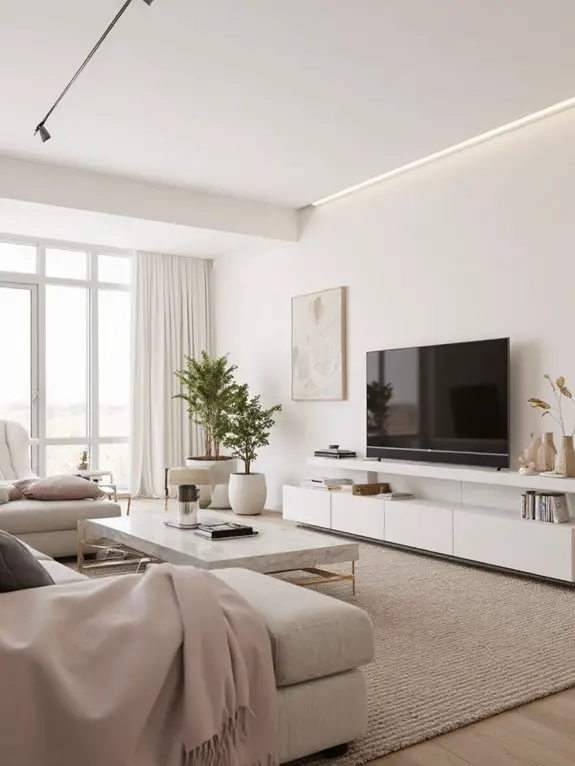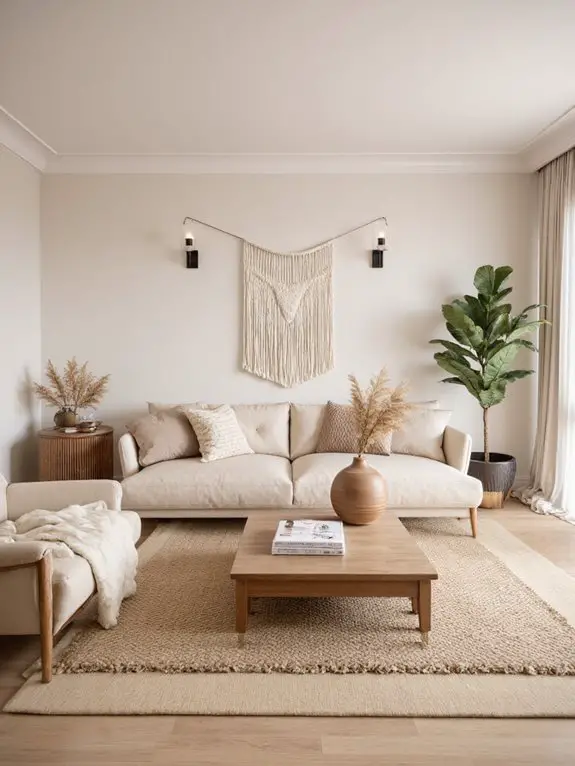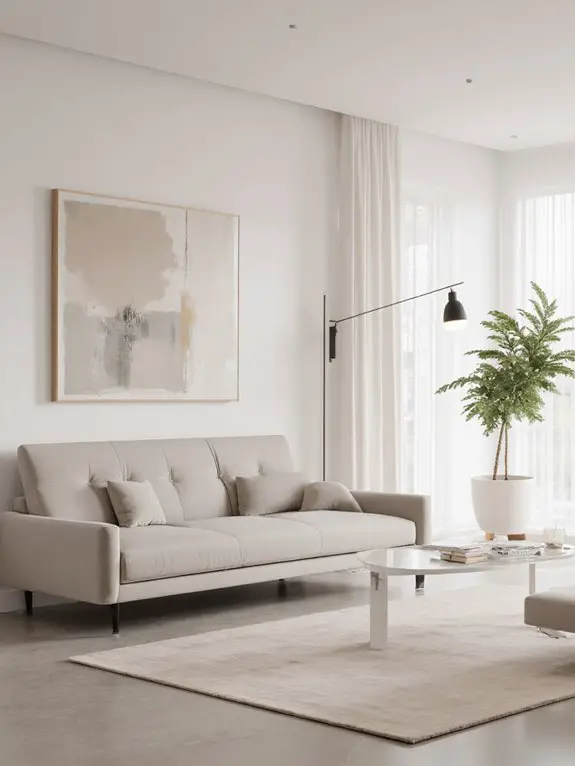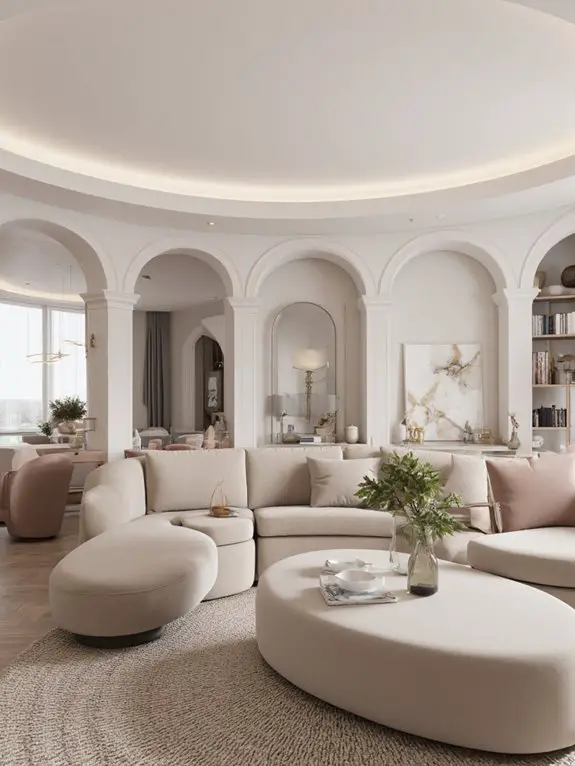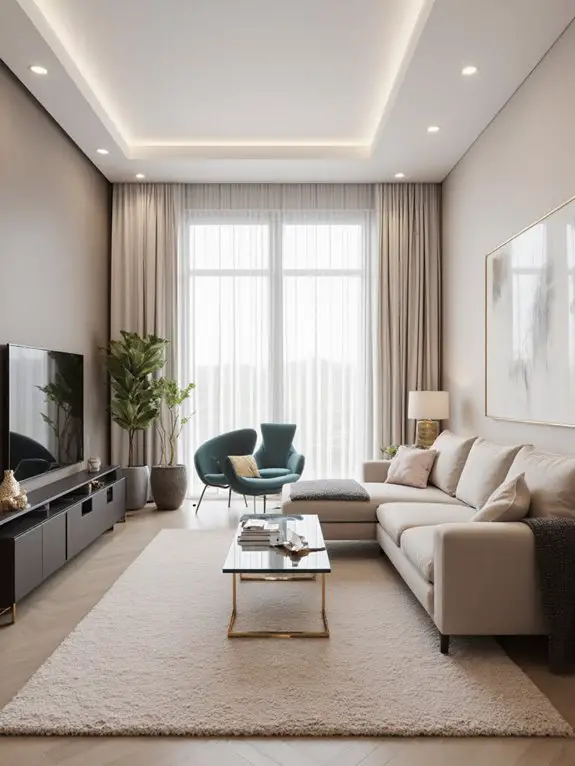I maximize small spaces with multi-functional furniture like sofa beds and wall-mounted shelves, using mirrors to create the illusion of more room. I arrange seating in U-shapes for conversation and position focal points like fireplaces or bold rugs to anchor the space. Modular furniture and symmetrical placements enhance balance, while tall bookcases and color-blocking define zones. Thoughtful lighting and strategic rug placement add depth and warmth. There’s more to explore for optimizing your layout.
Maximize Small Spaces With Multi-Functional Furniture
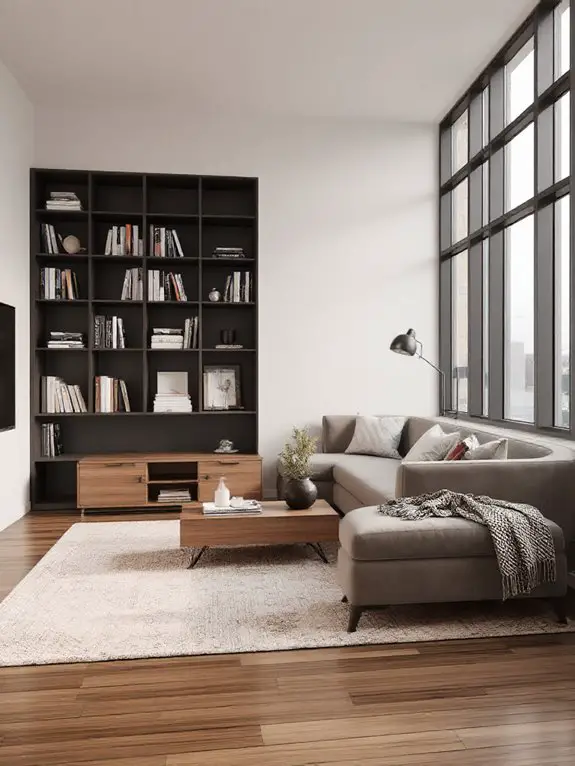
When working with a small living room, I’ve found that multi-functional furniture can be a game-changer because it allows you to make the most of every square foot. A sofa bed instantly transforms seating into a guest bed, while an ottoman with hidden storage keeps blankets or books out of sight.
Nesting tables save space when not in use, and a console table behind the couch can double as a workspace. Look for pieces with clean lines and neutral colors to maintain a cohesive look.
Prioritizing versatility guarantees your room stays functional without feeling cluttered.
Create a Focal Point Around the Fireplace
If you’re lucky enough to have a fireplace in your living room, it’s natural to make it the centerpiece of your design. I always start by arranging furniture to highlight the fireplace, ensuring it’s the first thing people notice when they enter.
I’ll use artwork or a mirror above the mantel to draw the eye upward, and I’ll keep the surrounding decor minimal to avoid clutter.
A stylish mantel display with a mix of books, candles, or vases adds personality. Lighting, like sconces or a table lamp nearby, enhances the cozy ambiance and reinforces the fireplace as the focal point.
Arrange Seating for Conversation-Friendly Layouts
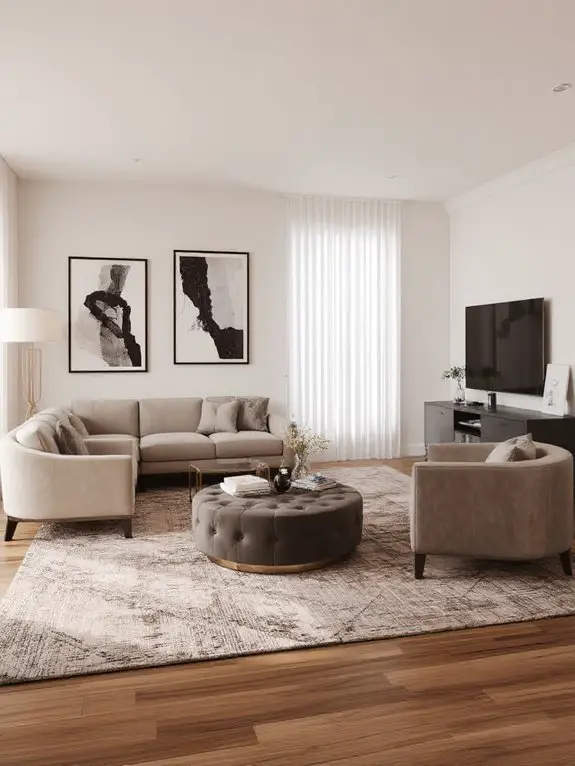
To foster an inviting atmosphere in your living room, I recommend arranging seating to encourage conversation and connection. Place sofas and chairs facing each other in a U-shape or circular formation, ensuring everyone can see and hear one another easily.
Keep seating pieces close enough for comfortable talking—about 6 to 8 feet apart. Avoid placing furniture directly against walls; pulling pieces inward creates a cozier, more intimate feel.
Add a central coffee table or ottoman to anchor the space and provide a shared surface. Include side tables within arm’s reach for convenience, making the area both functional and conducive to meaningful interactions.
Incorporate Symmetry for Balanced Design
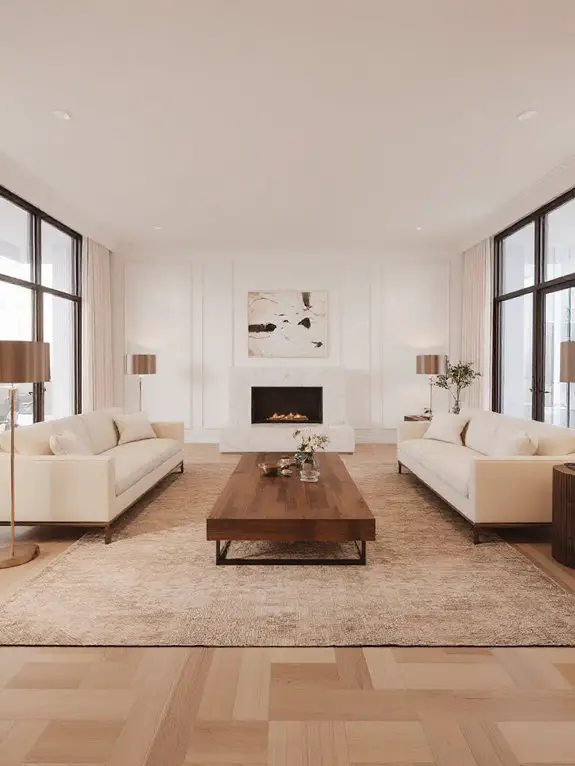
Incorporating symmetry creates a harmonious and balanced living room design that feels both intentional and visually pleasing. I like to place matching furniture pieces, such as sofas or armchairs, on either side of a focal point, like a fireplace or TV.
Flanking a central coffee table with identical side tables also enhances the effect. Symmetrical arrangements of artwork or decor, like paired lamps or wall sconces, add to the cohesive look.
It’s important to maintain proportion and scale—oversized pieces can disrupt the balance. This approach not only creates order but also makes the space feel calming and thoughtfully curated.
Use Rugs to Define Separate Zones
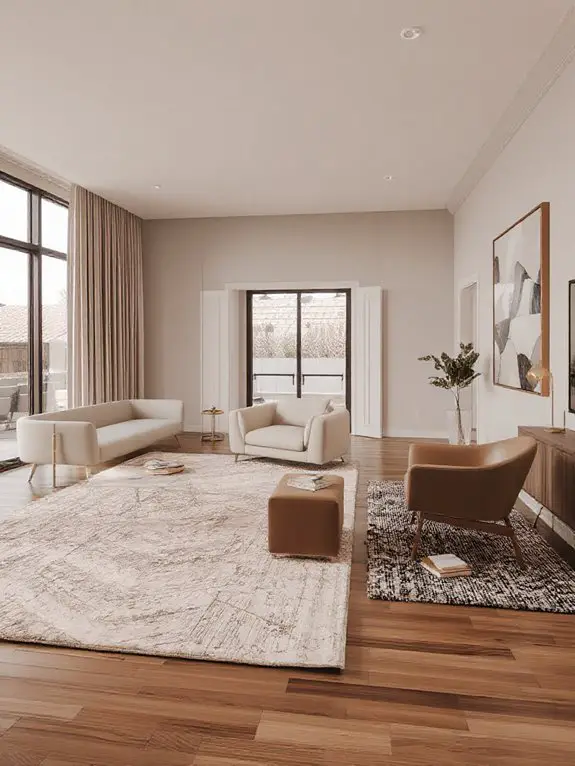
When arranging a living room, I often use rugs to delineate distinct areas, especially in open-concept spaces where defining zones is essential. By placing a large rug under the sofa and coffee table, I create a clear seating area, while a smaller rug can mark a reading nook or workspace.
I make sure each rug complements the room’s color scheme and texture for cohesion. Leaving some floor exposed around the edges keeps the space from feeling cramped.
This technique not only organizes the room visually but also adds warmth and dimension, making the layout both functional and inviting.
Optimize Natural Light With Strategic Placement
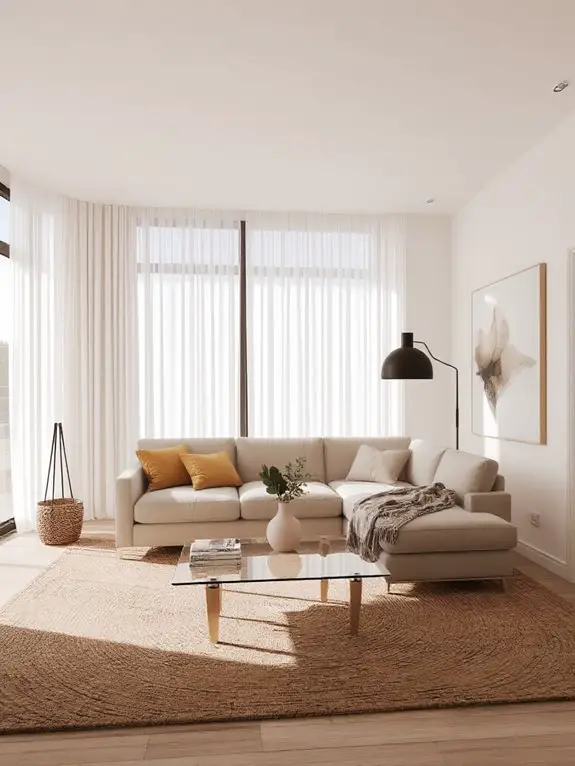
Though natural light can transform a living room, its potential is often underutilized without thoughtful placement. I always start by positioning furniture to maximize exposure to windows, ensuring seating areas face or are adjacent to light sources.
Mirrors are my secret weapon—I place them opposite windows to reflect and amplify sunlight throughout the space. Sheer curtains let light in while maintaining privacy, and I avoid blocking windows with bulky furniture.
If possible, I arrange seating near the brightest spots to create inviting, well-lit zones. Strategic placement of light-colored walls and decor also helps bounce light, making the room feel airy and open.
Design Around a Large Statement Piece
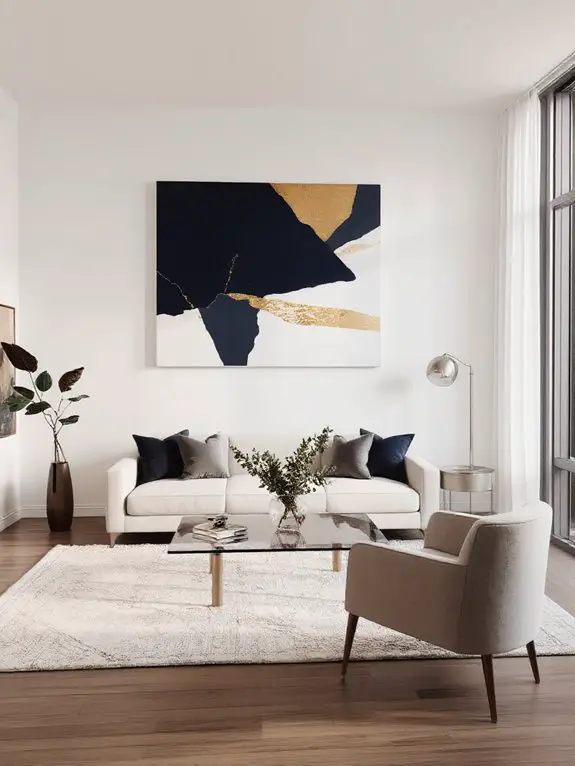
Designing around a large statement piece can anchor your living room and set the tone for the entire space. I start by positioning the piece, like a bold sofa or an oversized artwork, as the focal point.
Then, I arrange furniture to complement it, making certain balance and flow. For example, I might place chairs or a coffee table at angles that naturally draw the eye toward the statement piece.
Lighting is key—I use floor lamps or spotlights to highlight its features. Keeping the surrounding decor minimalist makes certain the piece stands out, creating a cohesive and impactful design.
Integrate Floating Shelves for Storage and Style
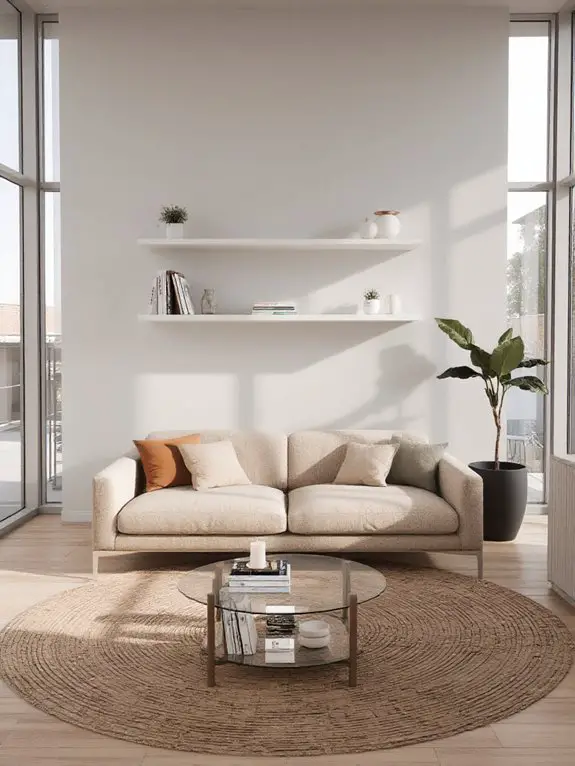
Floating shelves seamlessly blend functionality with aesthetics, offering a versatile storage solution that enhances any living room. I love how they free up floor space while showcasing decorative items, books, or plants.
When installing, I always consider the room’s layout—placing them near seating areas for easy access or above a sofa to create a focal point. Opting for materials like wood or metal adds texture, and mixing sizes gives depth.
I also use them to organize everyday items subtly, keeping clutter at bay. Floating shelves are both practical and stylish, transforming blank walls into personalized displays that reflect my taste.
Utilize Corner Spaces Creatively
When tackling corner spaces, I’ve found they’re often overlooked but hold immense potential to enhance both functionality and style. I like to use corner shelves or a small accent chair to make the most of these spots.
For added storage, a corner cabinet or ladder shelf can house books, decor, or everyday essentials. If space is tight, a floor lamp or potted plant can add vertical interest without overwhelming the area.
I’ve also seen corner desks or reading nooks turn underutilized spaces into practical, inviting zones. By thinking creatively, corners can become some of the most dynamic parts of the room.
Blend Open Floor Plans With Defined Areas
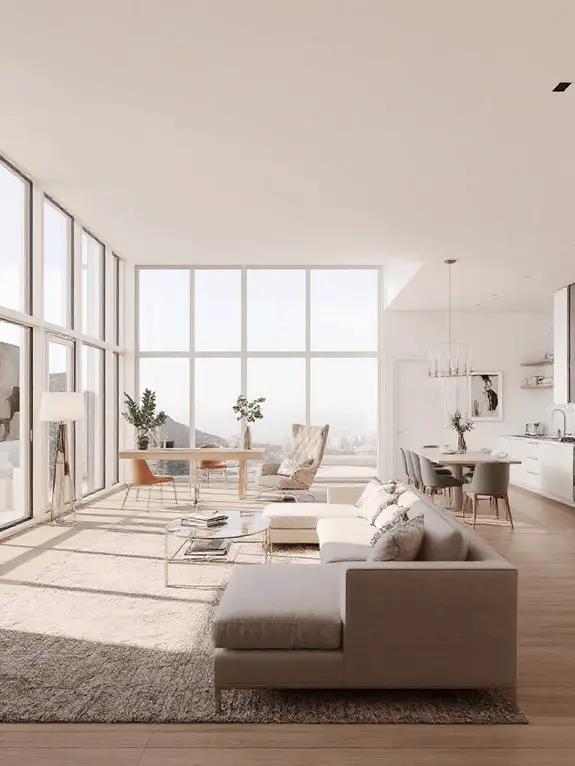
While open floor plans create a sense of spaciousness, they often lack the coziness and functionality of defined areas. To balance this, I use area rugs, furniture groupings, or partial walls to carve out distinct zones.
For example, positioning a sofa with its back to the dining area naturally separates the living room. I also rely on lighting to define spaces—pendants over a reading nook or floor lamps near seating areas.
Adding vertical elements like bookshelves or plants can subtly divide areas without closing them off. This approach maintains openness while ensuring each space feels intentional and inviting.
Arrange Furniture to Enhance Traffic Flow
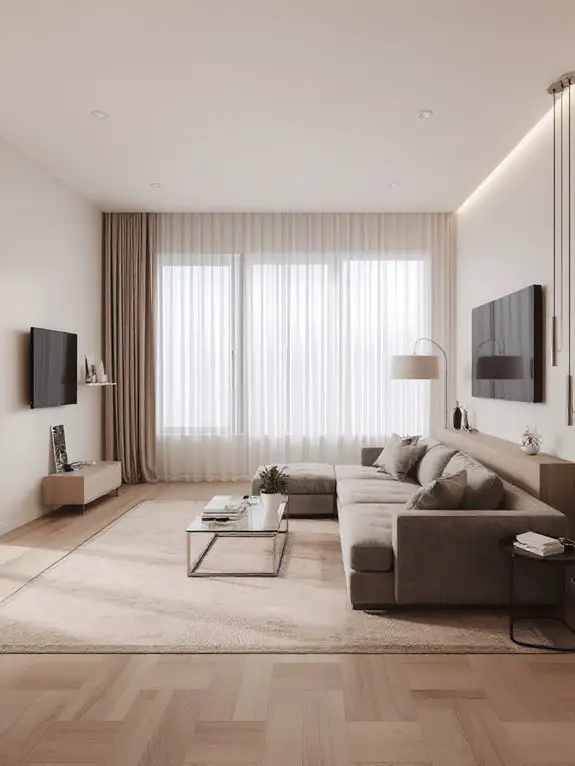
After defining distinct zones in an open floor plan, it’s important to evaluate how furniture placement impacts movement throughout the room. I start by mapping natural pathways—like the route from the entry to the kitchen—and verify they remain unobstructed.
I keep at least 3 feet between seating areas and walls or large pieces to allow easy walking. Angling furniture slightly can create flow without sacrificing coziness.
I avoid pushing everything against walls, as it disrupts conversation and traffic. Instead, I float sofas or chairs to define spaces while maintaining clear lanes. Testing the layout by walking through it helps spot bottlenecks before finalizing.
Layer Lighting for Ambiance and Functionality
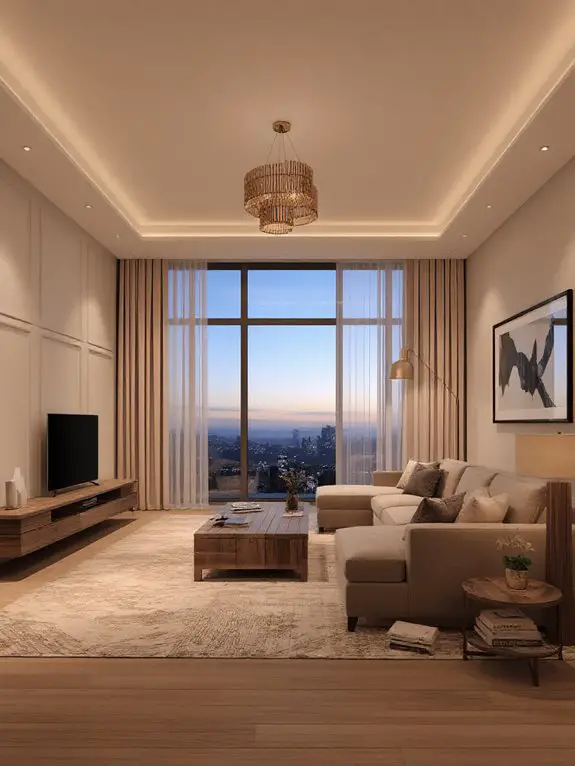
To create a well-lit living room, I focus on combining different light sources to balance ambiance and functionality. I start with overhead lighting for general illumination, then add floor lamps or sconces for task lighting near seating areas.
Table lamps on side tables soften the mood, while dimmers let me adjust brightness for different activities. I place accent lights to highlight artwork or shelves, creating depth.
Warm bulbs (2700K-3000K) make the space inviting, while cooler tones work for reading nooks. Layering light this way guarantees the room feels cozy yet practical, adapting effortlessly from daytime tasks to evening relaxation.
Incorporate Mirrors to Expand Visual Space
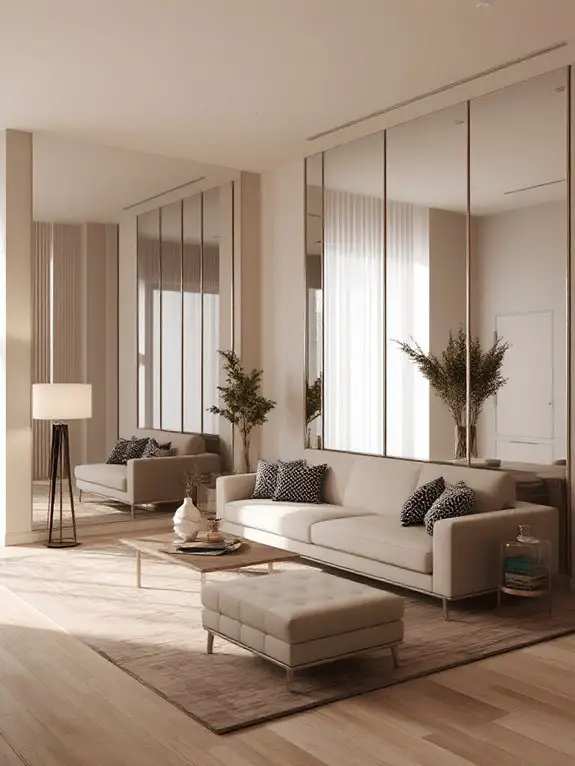
Mirrors are one of my go-to tools for making a living room feel larger and more open. I always place them strategically to reflect natural light or a focal point, like a window or artwork, which instantly creates depth.
Large mirrors work best, especially when positioned opposite a light source—they amplify brightness and make the space airier. I also use mirrored furniture or smaller accent mirrors grouped together for added dimension. Avoid cluttering the wall; a single statement mirror often has more impact.
This simple trick transforms even compact rooms, giving the illusion of expansiveness without altering the actual layout.
Create a Cozy Reading Nook
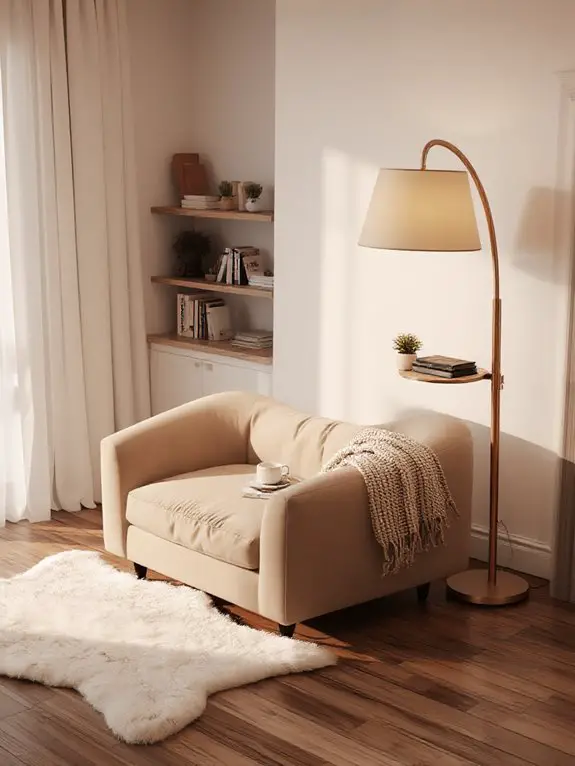
While designing a functional living room, I always carve out a dedicated reading nook—a quiet retreat that encourages relaxation and focus. I position a comfortable armchair near a window to maximize natural light, pairing it with a soft throw and a plush cushion for added comfort.
A small side table holds a reading lamp and a cup of tea, creating a practical yet inviting setup. I often add a bookshelf or floating shelves nearby to keep my favorite reads within reach.
Use Accent Chairs to Add Depth
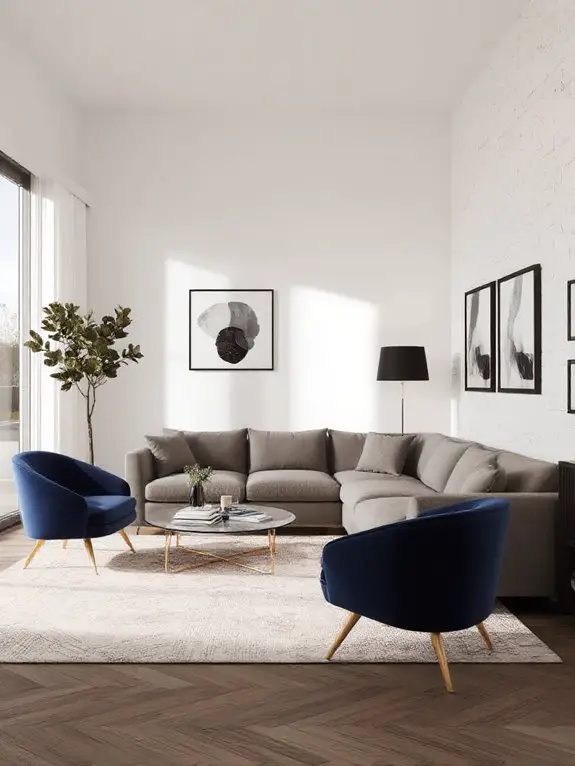
Accent chairs can transform the dynamics of a living room, adding both visual interest and functional depth. I often use them to break up monotony, placing one at an angle or slightly away from the main seating area to create layers. Choosing chairs with bold colors or unique shapes draws the eye and anchors the space.
I also consider scale—a taller back or bulkier frame can balance a room with low furniture. By positioning them thoughtfully, I guarantee they don’t block traffic flow but still invite conversation. They’re versatile pieces that elevate both style and practicality.
Combine Different Textures for Visual Interest
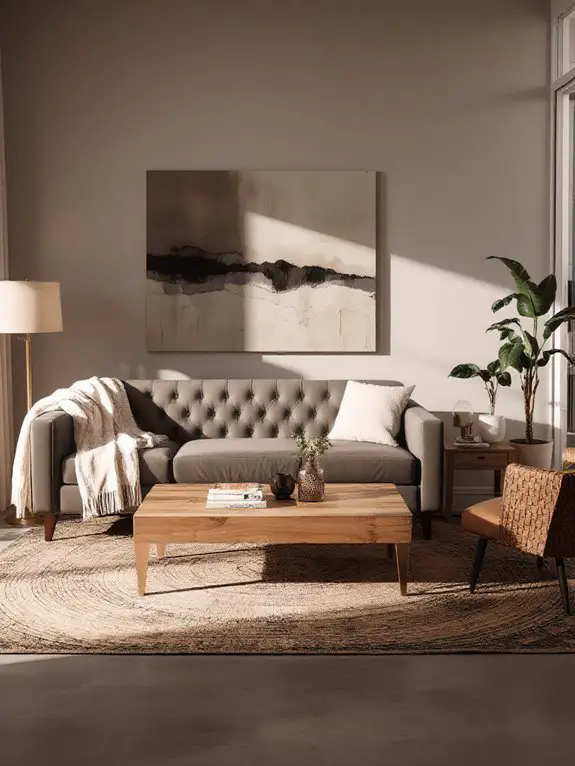
To create a living room that feels dynamic and inviting, I always recommend combining different textures to add depth and visual interest. Start with a plush rug underfoot, then layer in a sleek leather sofa and woven throw pillows for contrast.
Don’t shy away from mixing materials like wood, metal, and glass—they create a balanced yet intriguing look. A velvet armchair or a chunky knit blanket can soften harder surfaces, while a glossy coffee table adds polish.
The key is to blend textures thoughtfully, so the room feels cohesive rather than chaotic. This approach makes the space feel richer and more lived-in.
Design Around a TV Wall Unit
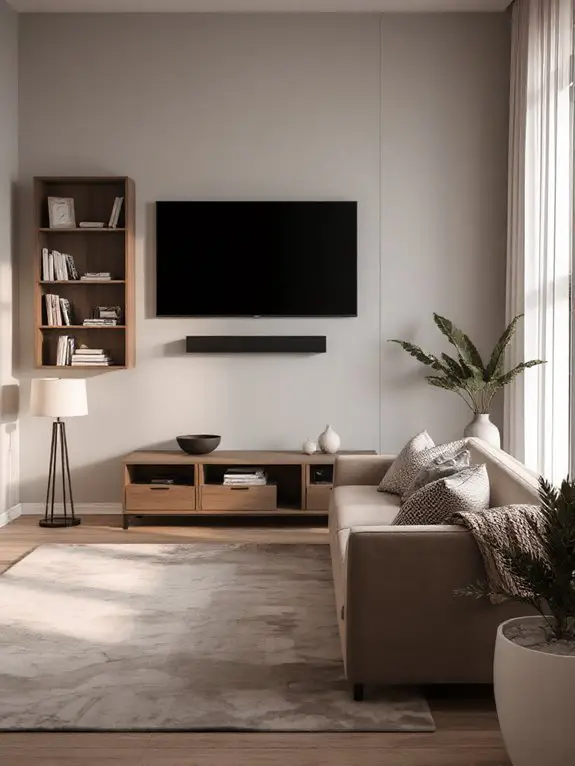
When designing a living room around a TV wall unit, I focus on creating a functional yet stylish focal point that complements the rest of the space. I start by positioning the unit at eye level to guarantee comfortable viewing and declutter it by hiding wires or using built-in storage.
I balance the TV’s dominance with symmetrical shelving, artwork, or decorative accents on either side. Choosing a unit with clean lines or warm wood tones helps it blend seamlessly with the room’s aesthetic.
I also leave enough space between furniture and the unit to maintain an open, inviting feel.
Incorporate Plants for Freshness and Greenery
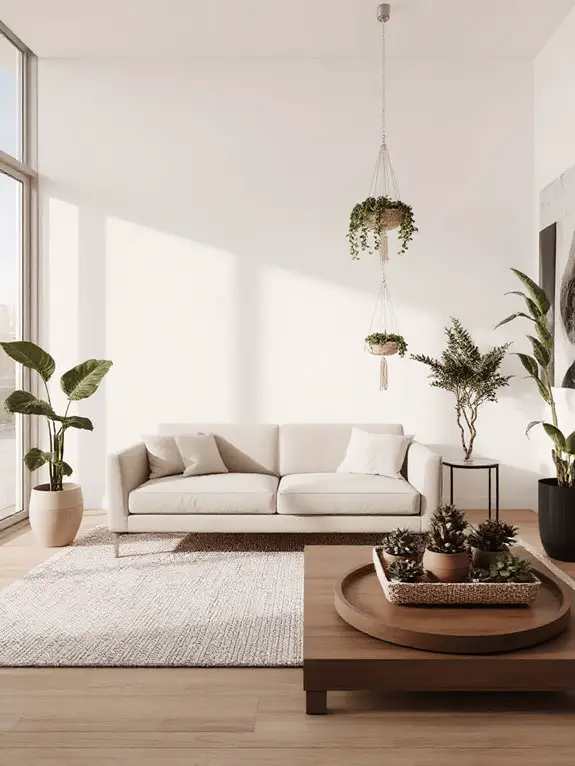
Plants can transform a living room, bringing life, color, and a sense of calm to the space. I love adding indoor plants like snake plants or pothos because they’re low-maintenance and thrive in various light conditions.
A tall fiddle leaf fig in a corner can create a striking focal point, while smaller plants like succulents look great on shelves or coffee tables. Grouping plants of different heights and textures adds depth and visual interest.
I also recommend using stylish planters that complement your decor to keep the space cohesive. Plants not only enhance aesthetics but also improve air quality, making your living room feel fresher and more inviting.
Use Low-Profile Furniture for an Airy Feel
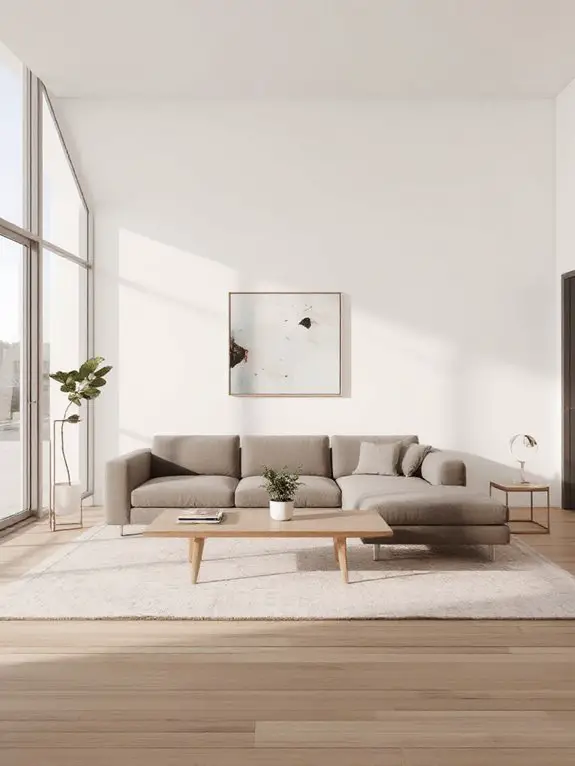
Opting for low-profile furniture can instantly create a sense of openness in your living room, especially if you’re working with limited space. I find that pieces like streamlined sofas, low coffee tables, and minimalist ottomans make the room feel less cramped.
By keeping furniture closer to the ground, you maximize vertical space, which draws the eye upward and makes the area seem larger. I also recommend choosing furniture with exposed legs, as they allow light to flow underneath, enhancing the airy vibe.
This approach not only improves functionality but also gives your living room a modern, uncluttered aesthetic.
Arrange Furniture to Highlight Artwork
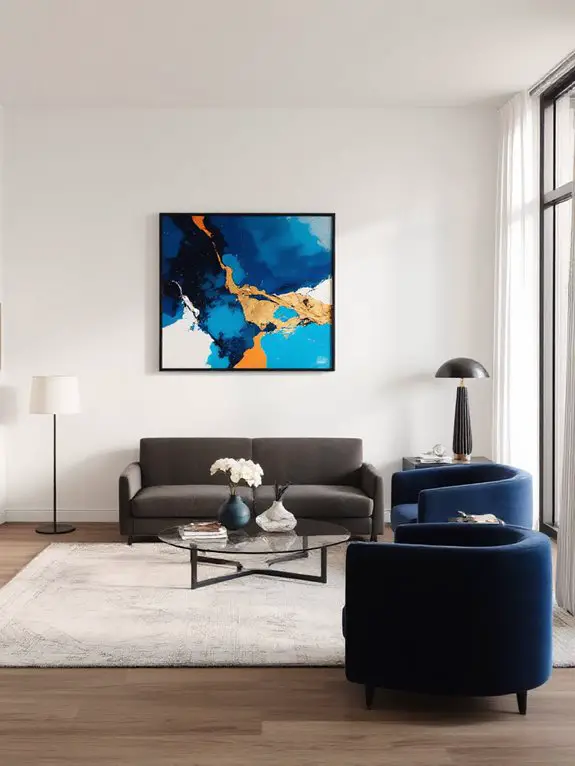
Arranging furniture to highlight artwork can transform your living room into a gallery-like space that feels both cohesive and intentional. I start by positioning key pieces—like sofas or chairs—to face the artwork, ensuring it’s the focal point. I keep furniture low-profile to avoid obstructing the view and maintain enough distance for the art to breathe.
Lighting is pivotal; I use track lights or wall sconces to illuminate pieces without glare. I also consider scale—larger furniture complements bigger artworks, while smaller pieces pair well with delicate arrangements. This approach not only showcases the art but also ties the room together visually.
Create a Dual-Purpose Entertainment and Work Area
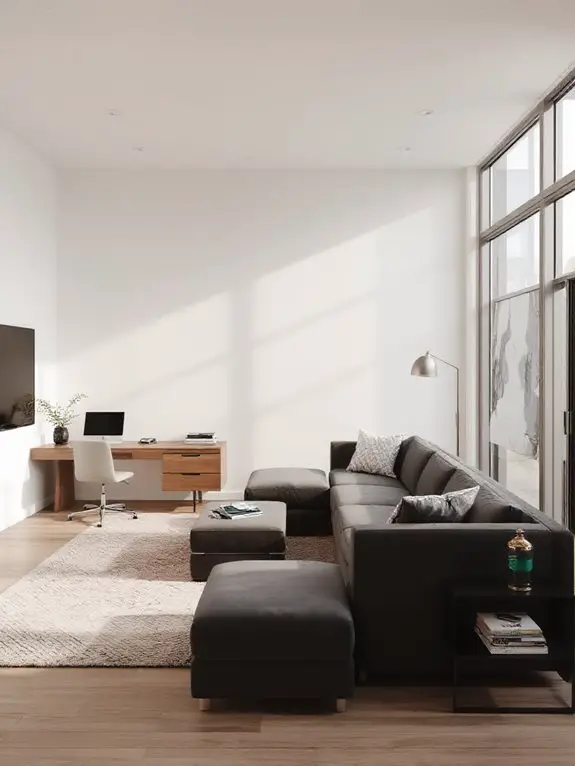
When designing a dual-purpose entertainment and work area, I begin by selecting a layout that separates the two functions without feeling disjointed. I position the TV and seating for relaxation on one side, ensuring clear sightlines and comfort. On the opposite side, I set up a functional workspace with a desk, chair, and adequate lighting.
To maintain cohesion, I use cohesive color schemes and complementary furniture styles. Storage solutions like ottomans or side tables keep clutter at bay, while rugs or lighting help define each zone. The key is balancing utility and aesthetics, creating a space that’s both productive and inviting.
Utilize Vertical Space With Tall Bookcases
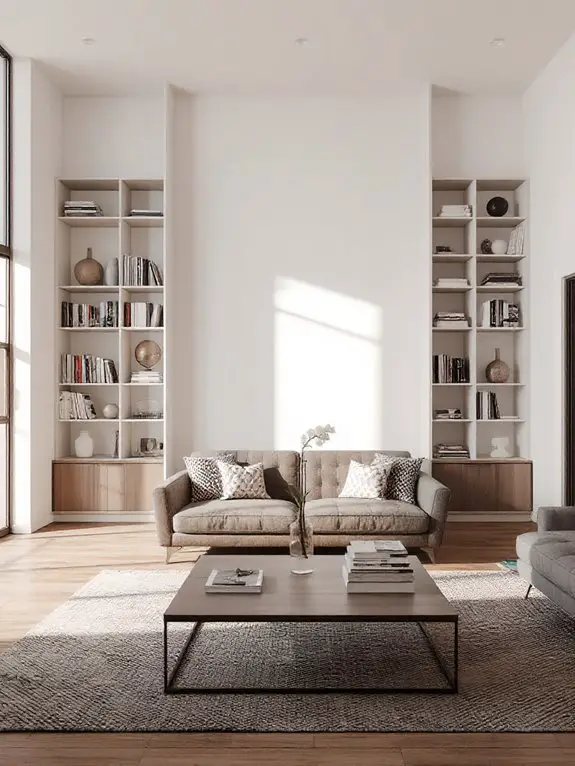
Maximizing vertical space with tall bookcases is an effective way to enhance storage and style in a smart living room. I’ve found that floor-to-ceiling bookcases not only store books but also display decor, plants, and keepsakes, making the room feel curated.
Choosing bookcases with adjustable shelves allows me to customize the layout for different items. To avoid a cluttered look, I mix closed cabinets with open shelves, keeping bulkier items hidden.
Anchoring the bookcase to the wall guarantees safety, especially in homes with children or pets. This approach frees up floor space, making the room feel larger and more organized while adding visual interest.
Design Around a Statement Coffee Table
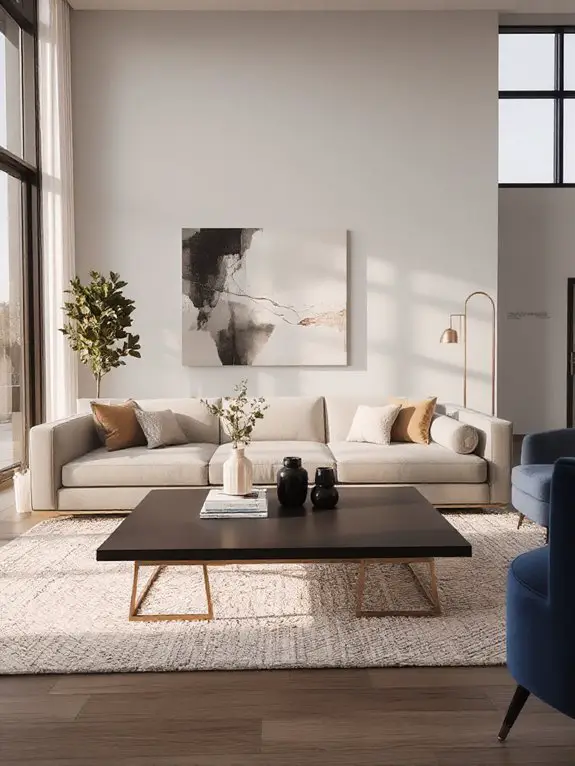
A statement coffee table can instantly elevate the centerpiece of your living room, anchoring the space with both functionality and style. I start by choosing a table that reflects my personal aesthetic—whether it’s a bold geometric design, a sleek marble top, or a rustic wooden piece.
Its size and shape should complement the seating arrangement, ensuring easy access and conversation flow. I layer it with curated decor like art books, a sculptural vase, or a tray for practicality.
Incorporate Modular Furniture for Flexibility
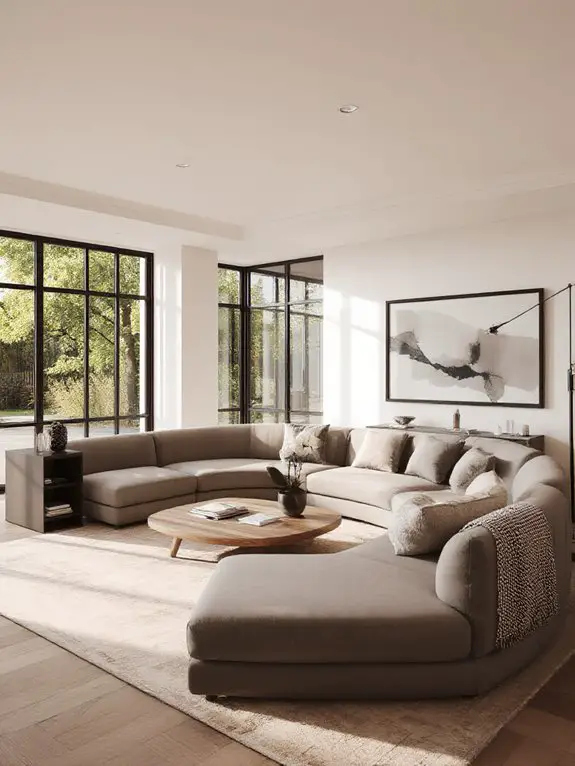
Modular furniture’s adaptability makes it a game-changer for creating a living room that’s both functional and versatile. I’ve found that pieces like sectional sofas with movable components or stackable ottomans let me rearrange the space effortlessly for different needs, whether it’s hosting guests or relaxing solo.
Adds like modular shelving units or nesting tables can be reconfigured to fit changing storage or display requirements. The beauty of modular furniture lies in its ability to grow and adapt with my lifestyle, making it a practical investment.
Use Color Blocking to Define Zones
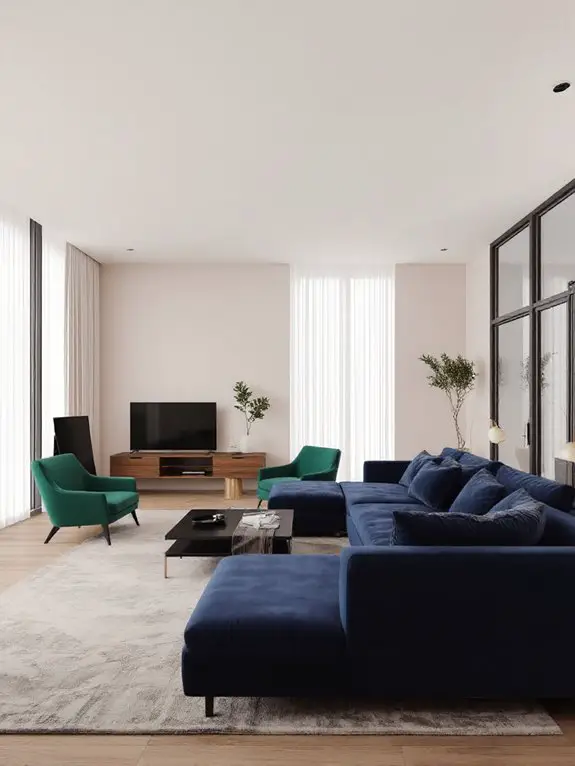
While open-concept living rooms offer spaciousness, color blocking helps me carve out distinct zones without sacrificing flow. By using contrasting paint colors, rugs, or furniture, I can visually separate the seating area from the dining or workspace.
For example, a bold navy accent wall behind the sofa defines the lounge spot, while a warm beige rug anchors the reading nook. I choose complementary shades to maintain harmony, ensuring the space feels cohesive.
Layering textures, like pairing a velvet chair with a sleek table, adds depth. This technique not only organizes the room but also creates a dynamic, intentional design.
Frequently Asked Questions
How to Choose the Right Paint Color for a Living Room?
I’ll consider the room’s natural light, size, and mood I want to create. I’ll test samples on walls and observe them at different times of day. I’ll also think about my furniture and decor for harmony.
What Are the Best Ways to Hide TV Wires?
Cable clutter can be cunningly concealed. I’d channel cords through walls, tuck them behind furniture, or use sleek cord covers. I’ve stuffed wires in decorative baskets or loops to minimize the mess, blending them seamlessly into my space.
How to Make a Living Room Pet-Friendly?
I choose durable, easy-to-clean fabrics and furniture covers to withstand pet wear. I avoid fragile decor and use pet-safe plants. I’ll also set up cozy spots for my pet to relax and keep toys organized.
What Type of Curtains Work Best for Large Windows?
For large windows, I’d opt for floor-to-ceiling curtains to emphasize height and space. Lightweight fabrics like linen or sheer materials let in natural light, while blackout options offer privacy and light control when I need it.
How to Reduce Noise in a Living Room?
Noise sneaks in like an uninvited guest, but I’ve found thick rugs, heavy curtains, and plush furniture swallow sound. I also add bookshelves or wall art to break up echoes—it’s like giving noise a cozy blanket to nap under.

